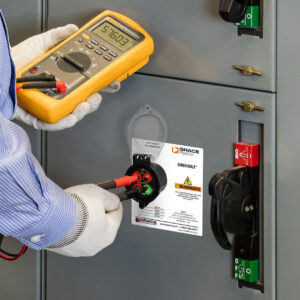Enhancing Lockout/Tagout Safety: Best Practices and Solutions for Electrical Safety Programs
Contributed by Grace Technologies

Voltage indicators provide visual confirmation of voltage presence, enabling workers to take necessary precautions.
Lockout/Tagout (LOTO) procedures are crucial for ensuring electrical safety in the workplace while complying with NFPA 70E and OSHA standards. Compliance with LOTO regulations not only protects employees but also helps companies avoid costly citations and accidents. In this article, we will delve into the significance of LOTO safety, discuss best practices for compliance, and introduce effective solutions to enhance electrical safety programs.
Understanding NFPA 70E and OSHA Standards
LOTO procedures, as outlined in NFPA 70E Article 120.5, are designed to control hazardous energy sources, preventing unexpected startup or release of stored energy during maintenance or servicing. By isolating and securing energy sources with locks and tags, LOTO ensures the safety of workers performing tasks on electrical equipment, aligning with OSHA standards.
To establish a strong LOTO program that complies with NFPA 70E and OSHA, companies should start by conducting a comprehensive energy control audit. This audit, in accordance with NFPA 70E 120.5, identifies all energy sources and provides a clear understanding of the necessary procedures and equipment needed for effective lockout. Engaging qualified personnel in the development of LOTO procedures ensures that the program meets NFPA 70E requirements and addresses the specific risks within the workplace.
Augmenting Your Electrical Safety Program with Test Points and Voltage Indicators
Thorough training, as mandated by OSHA standards, is another critical aspect of LOTO safety. Employees must receive proper education on LOTO procedures, including the identification and isolation of energy sources, proper application and removal of locks and tags, and the significance of following established protocols. Regular refresher training sessions and ongoing communication, in compliance with OSHA standards, reinforce the importance of LOTO safety and ensure that employees stay up to date with best practices.
In addition to comprehensive training, companies can enhance LOTO safety by adopting advanced solutions such as high impedance protected test points and voltage indicators. These devices serve as valuable tools in verifying the absence of voltage and ensuring the safety of maintenance personnel, in compliance with NFPA 70E requirements. Test points, installed on enclosures, allow qualified workers to conduct voltage testing without opening the enclosure, minimizing the risk of accidental contact with energized parts. Voltage indicators provide visual confirmation of voltage presence, enabling workers to take necessary precautions.

Companies can enhance LOTO safety by adopting advanced solutions such as high impedance protected test points and voltage indicators.
Integration of Test Points and Voltage Indicators in LOTO Procedures
Integrating test points and voltage indicators into LOTO procedures offers numerous benefits. Firstly, it streamlines the process, reducing downtime and increasing efficiency, in line with NFPA 70E guidelines. By eliminating the need to open enclosures for voltage testing, test points save valuable time, allowing maintenance tasks to be performed more swiftly. This enhanced productivity translates into cost savings and improved operational efficiency.
Furthermore, test points and voltage indicators enhance safety by minimizing the risk of accidental energization. By conducting voltage testing externally, maintenance personnel are shielded from potential electrical hazards, reducing the likelihood of electrical accidents. These devices also contribute to compliance with LOTO regulations by providing a reliable method for verifying the absence of voltage before work begins, in accordance with NFPA 70E 120.5 guidelines.
Enhancing Your LOTO Safety Approach
It is worth noting that while test points and voltage indicators play a significant role in LOTO safety, they should not be considered standalone solutions. They should be integrated as part of a comprehensive LOTO program that includes proper training, equipment maintenance, and periodic reviews of procedures, as specified by OSHA standards. LOTO safety requires a holistic approach that encompasses multiple elements to ensure maximum effectiveness.
By prioritizing LOTO safety and implementing best practices in compliance with NFPA 70E and OSHA, companies can create a safer work environment and protect their employees from electrical hazards. Compliance with NFPA 70E and OSHA standards is not only a legal requirement but also a critical step in safeguarding employees and minimizing the risk of electrical accidents. Adhering to LOTO regulations demonstrates a commitment to worker well-being and helps companies avoid costly citations and penalties.

Investing in the right tools, such as test points and voltage indicators, further enhances LOTO procedures and supports compliance with NFPA 70E and OSHA standards.
Cultivating a Safer Work Environment
Investing in the right tools, such as test points and voltage indicators, further enhances LOTO procedures and supports compliance with NFPA 70E and OSHA standards. These devices offer a reliable and efficient method for verifying the absence of voltage. By allowing voltage testing without opening enclosures, test points reduce the risk of accidental contact with energized parts, in line with NFPA 70E requirements.
Voltage indicators, with their visual confirmation of voltage presence, provide an additional layer of safety and help workers take necessary precautions, as recommended by NFPA 70E. By integrating these devices into LOTO procedures, companies can enhance worker safety, improve productivity, and comply with industry standards.
However, it is essential to remember that LOTO safety extends beyond the use of test points and voltage indicators. A comprehensive LOTO program should encompass thorough training, proper equipment maintenance, periodic reviews, and ongoing communication, as specified by OSHA standards. By adopting a holistic approach to LOTO safety, companies can create a culture of safety, mitigate risks, and ensure compliance with NFPA 70E and OSHA regulations.
In conclusion, prioritizing LOTO safety is of utmost importance for companies aiming to protect their employees and comply with industry standards. By conducting a comprehensive energy control audit, providing thorough training, and integrating advanced solutions like test points and voltage indicators, companies can enhance LOTO procedures, improve productivity, and create a safer work environment. Compliance with NFPA 70E and OSHA standards not only minimizes the risk of accidents but also demonstrates a commitment to the well-being of employees. Together, we can achieve a safer tomorrow through effective LOTO safety and electrical hazard prevention. ESW
Grace Technologies empowers safety and productivity with innovative electrical safety and predictive maintenance solutions. With a global reach, Grace is optimizing maintenance practices for a safer, more efficient future (graceport.com).
Share on Socials!
Reconstructing How We Deliver Electrical Safety Knowledge to Minimize Exposure and Help Save Lives
When is De-Energized Equipment Not Actually De-Energized and Safe to Work On?
MELTRIC Q&A
Leaders in Electrical Safety
• Aramark
• Bowtie Engineering
• Enespro
• Ericson
• I-Gard Corporation
• IRISS
• KERMEL, INC.
• Lakeland Industries
• MELTRIC Corporation
• National Safety Apparel
• National Technology Transfer
• Oberon
• Saf-T-Gard
• SEAM Group
Subscribe!
Sign up to receive our industry publications for FREE!







